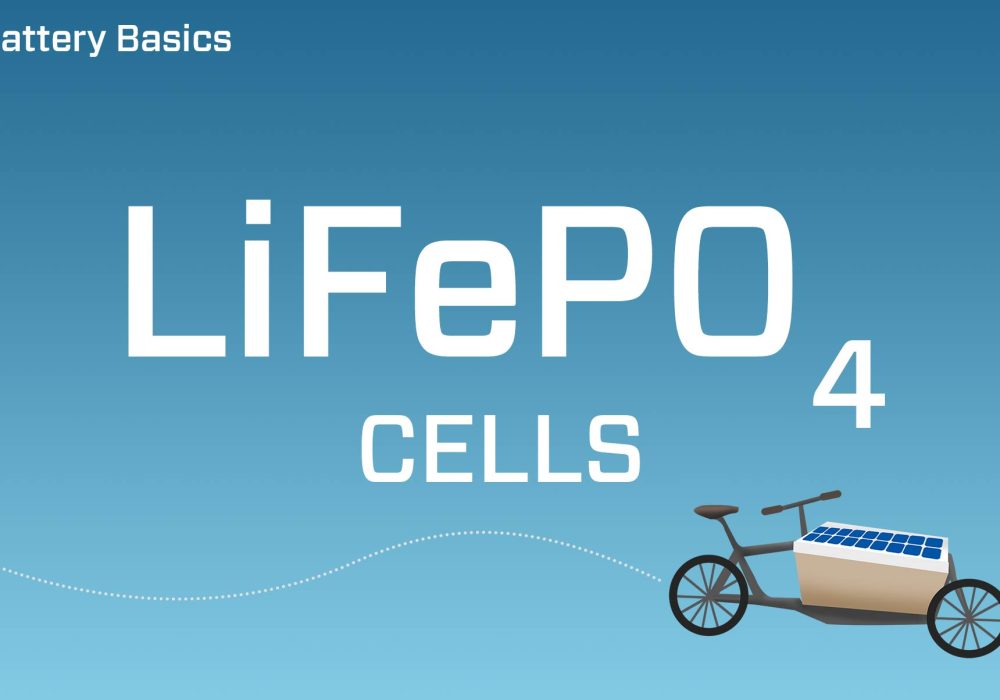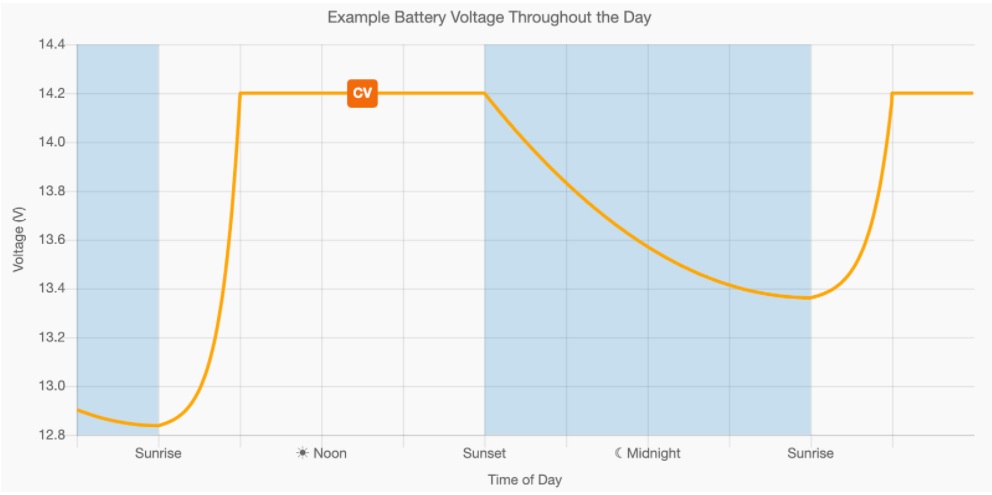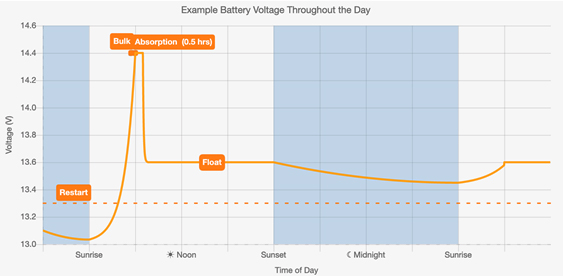
The main difference between single and multistage charge profiles for LiFePO4 batteries has to do with the chemistry of the battery. Unlike lead-acid batteries, once a LiFePO4 cell achieves its charge voltage, it is nearly fully charged. Since various cells within the pack can charge at different speeds, a short balancing time is needed at the end of the charge cycle in order to have each cell obtain its ideal charge voltage. Since the amount of imbalance can vary greatly, the optimal absorption/ balancing time also changes, but 6-30 minutes per charge cycle should suffice.
| LiFePO4 | |
|---|---|
| Chemistry | Lithium Iron Phosphate |
| Nominal Voltage (per cell) | 3.2V |
| Max Charge Voltage | 3.65V |
| Charge Profile | 2 Stage CC-CV* or Multistage |
What voltage and charge profile should I choose for my LiFePO4cells?
There is a little debate in the community whether it is harmful to a LiFePO4 battery to be maintained at its max voltage (3.55V-3.65V per cell / 14.2V-14.6V for a 4S battery pack) indefinitely. One opinion is that it is better not to maintain the voltage indefinitely, rather use a multistage profile which would maintain a voltage which equates closely to (or below) the resting voltage of a fully charged battery (once a charge cycle has been completed), extending the life of the cells.
If an application is going to be cycling a cell regularly, then of course it will take time daily to recharge, resulting in the amount of time at the charge voltage not being the same as an application where a fully charged battery will be maintained indefinitely at its max CV. As such, the benefits of multistage vs 2-stage charging can also be relevant to your application.
Given the anticipated life cycle of lithium batteries, and their more or less recent emergence into applications such as we are seeing today, it might be several years before we know if 2-stage CC-CV* or multistage makes any appreciable difference.
Genasun pre-programmed controllers for LiFePO4 have a 2-stage CC-CV* charge profile and a per cell charge voltage of ~3.55V (14.2V for a 4S battery pack) in order to minimize stress on the cells without sacrificing significant State of Charge (SOC) and improving performance and longevity of the battery. For more info, read this article.
4S CC-CV* LiFePO4 example:

| 4S LiFePO4 | CC-CV* |
|---|---|
| Constant Current | Voltage increases |
| Constant Voltage | 14.2V – 14.6V |
However, Genasun can also provide a multistage charge profile for LiFePO4 batteries. For example, we have suggested the charge profile with the following voltages: Absorption 14.4V – Absorption time 0.5 hours – Float Voltage: 13.6V – Restart Voltage 13.2V (see below the graphic).
To order a Genasun charge controller with a multistage charge profile, follow the instructions by selecting “Choose Options” of the part number GV-xx-Li-CV.
4S Multistage LiFePO4 example:

| 4S LiFePO4 | Multistage LiFePO4 |
|---|---|
| Absorption Voltage | 14.2V – 14.6V |
| Constant Voltage | 15-30 min. |
| Float Voltage | 13.4V – 13.8V |
Genasun charge controllers are off-the-shelf for 3S or 4S LiFePO4 and can be programmed in the factory CC-CV* or multistage charge profiles for any Li battery with the SKUs GV-5-Li-CV, GV-10-Li-CV, and GVB-8-Li-CV.
| Genasunmodels | CC-CV* 3S LiFePO4 | CC-CV* 4S LiFePO4 | Multistage or CC-CV LiFePO4 |
|---|---|---|---|
| GV-5 | GV-5-Li-10.7V | GV-5-Li-14.2V | GV-5-Li-CV |
| GV-10 | GV-10-Li-CV | GV-10-Li-14.2V | GV-10-Li-CV |
| GVB-8 (Boost) | GVB-8-Li-CV | GVB-Li-14.2V | GVB-8-Li-CV |
| GVB-8-WP (Boost) | – | GVB-Li-14.2V-WP | – |
Blue Sky Energy controllers SC30 and SB3000i can be programmed by the user for any type of charge profile by their onboard display. The SB1524iX, SB2512iX-HV, and SB3024iL/SB3024DiL can be fully programmable when paired with an external accessory. For more info on how to program a Blue Sky Energy charge controller for a LiFePO4battery with the IPN ProRemote, read this article.
| Blue Sky Energy models | CC-CV* or multistage LiFePO4 |
|---|---|
| SC30 / SB3000i | programmable via onboard display |
| SB1524iX / SB25iX-HV | programmable(1) |
| SB3024iL / SB3024DiL | programmable(1)(2) |
(1) Nonvolatile memory programmable by users with the IPN ProRemote, BT Connect, or UCM (2) Limited programming via internal dip switches
As always, please drop us a line for details or any questions.
